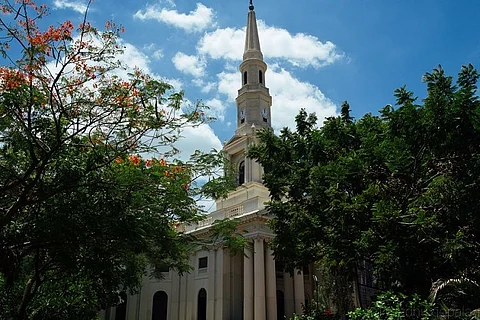

Chennai is most commonly thought of as a gateway to Tamil Nadu, the land of thousands of magnificent temples. What’s less known is that the city has had a long association with Christianity since as far back as the 1st century AD, and is peppered with beautiful churches built by the colonial powers between the 16th and 20th centuries.
The Church of Our Lady of Light, locally called the Luz Church, is probably the oldest church in Chennai. In the early 16th century, Vasco da Gama, the famous Portuguese explorer, discovered a maritime route to India. Right after that, it is said that 8 Portuguese priests came to India to preach Christianity. On their way to the eastern shores of south India, they were hit by bad weather and got lost at sea. Legend has it that a bright light mysteriously appeared out of nowhere and guided them to safety. This church was built in the year 1516 at the place that the light led them to.
The 16th century Luz Church
There are two more iconic churches in Chennai originally built by the Portuguese, and both have a deep connection with St. Thomas, one of the 12 apostles of Jesus Christ. It is said that he was unable to believe the news of Jesus Christ’s resurrection, and needed proof to be convinced of it - this was the origin of the phrase ‘doubting Thomas’. St. Thomas is believed to have travelled to south India in the middle of the 1st century AD, to spread the gospel. Many historians credit him with bringing Christianity to India. He is said to have arrived on the Malabar Coast and eventually made his way to the eastern coast. In 72 AD, he was killed at St Thomas Mount and buried in the Mylapore area of Chennai. This version of history is however debated by many.
The cool interiors of the church at St. Thomas Mount
Many centuries later, the Portuguese built one church with its altar at the spot where the apostle was martyred, and another over his grave near Mylapore. The church at St. Thomas Mount is said to date back to 1523, and commands stunning views of the city. The church built on St. Thomas’ grave was rebuilt by the British in 1893 as the Santhome Basilica. The magnificent white Gothic style church stands close to the Marina Beach, and pilgrims from all over the world come to pray at the apostle’s tomb.
A part of the massive Santhome Basilica
Inside the Santhome Basilica
The St. Mary’s Church built by the British within the Fort St. George complex, is said to be the oldest Anglican church east of the Suez. It was built in 1680, for the families living in the fort to worship in. It was given a supposedly bomb-proof roof that could cause cannonballs to bounce right off. Two illustrious gentlemen whose marriages were registered in this church were Robert Clive and Elihu Yale. The former was instrumental in expanding the British Empire to India, and the latter served as the President of Fort St George, and was also a patron of the college that went on to be named after him as Yale College.
St. Mary’s Church
Chennai had a sizeable population of Armenians, and the British East India Company granted them a plot of land to build a church on. To start with, they built a simple wooden structure. A proper church was built in 1712, but it was destroyed in a French siege in 1772, and was then rebuilt in its present location - the grounds of an Armenian cemetery. It is called the Church of St. Mary, or simply, the Armenian Church, and stands in the in the middle of the noisy Georgetown area that is the trading hub of Chennai. Since there are almost no Armenians in Chennai now, there is no regular service in this church.
Armenian Church
St George’s Cathedral was built in 1815, with a part of the funds for its construction contributed by the local Christian population. It became a cathedral in 1835. The most significant event that took place here was the founding of the Church of South India in the year 1947. The cathedral is an exquisite structure with tall pillars and marbles statues that serve as memorials to important members of the British community who worshipped here.
St. George’s Cathedral
Inside St. George’s Cathedral
A sight that travellers passing through the Egmore railway station cannot miss is the soaring spire of the St. Andrew’s Church, also called The Kirk. It was built between 1818 and 1821 for the Scottish community living here. The back of the church is circular in shape, and is topped by a huge dome that is bright blue on the inside - it gets its color from crushed lapis lazuli, a blue metamorphic rock. With its imposing pillars, stained glass panels and bright blue dome, this church is a sight to behold.
St. Andrew’s Church
This trail is by no means exhaustive, but almost all of these churches are major landmarks, and they pretty much define the neighborhoods they are in. The area Luz, for example, gets its name from the Portuguese word for light. Similarly, Cathedral Road, Santhome, St. Thomas Mount and Armenian street get their names from the churches and their histories. Towering above the hustle and bustle around them, these churches are cool, tranquil sanctuaries that make you forget that they are smack in the middle of Chennai’s busiest parts.
Photos and text by Madhumita Gopalan
Madhumita Gopalan is a photographer, blogger and history enthusiast who loves photo-documenting travel, culture and architecture. She blogs at www.madhugopalan.com
Also read:
Note: It has been added that the story of St Thomas is debated.